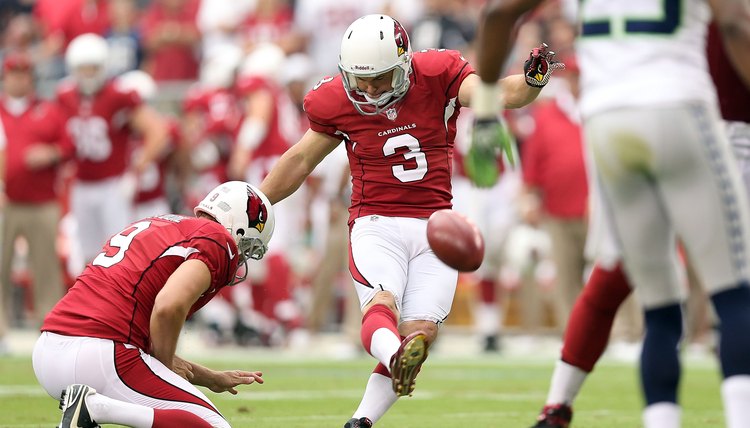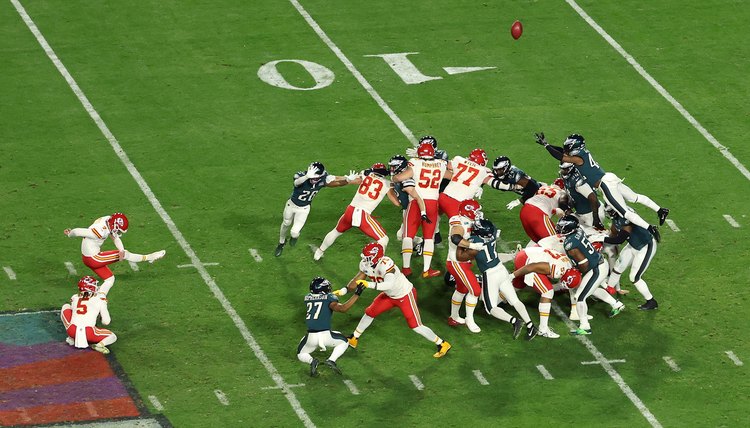How to Kick a Football 50 Yards

Kicking is an important part of American Football which is why having a big legged punter or placekicker is so important for a good special teams program. While just about every kicker can hit an extra point, a NFL kicker who can get a 50 yarder through the uprights gives a team a chance to score by penetrating the opponent’s 33-yard line. A punter who can boom the ball 50 yards or more downfield can reverse a team’s field position instantly.
As for the kickoff, a 50-yard kick isn’t long by pro or college standards, but kickoffs originate from the 40-yard line in high school, so a 50-yard kickoff represents a respectable effort that reaches the opponent’s 10-yard line. So as you start your journey to become your high school team’s best kicker or maybe the greatest kicker in NFL History, here is what you need to do to kick a football 50 yards.
How to kick an English Soccer-Style Field Goal?

Christian Petersen/Getty Images Sport/Getty Images
Walk three steps backward from the spot where the field goal will be held. For a 50-yard field goal, the line of scrimmage is at or near the 33-yard line, with the ball being spotted at the 40. Add 10 yards for the depth of the end zone and 7 yards for the spot of where the holder will handle the snap and place the ball for the 50-yard field-goal attempt.
Move two steps sideways, parallel to the line of scrimmage. When you’re facing the ball, move left if you’re right-footed.
Turn sideways, aiming your body just left of the spot at which the ball will be held. Set your right foot a bit farther back than your left. Flex your knees just a bit and lean your upper body forward. Once you’ve taken your stance, don’t move your feet until the ball is snapped.
Take a short step with your left foot as soon as the ball is snapped, followed by two full strides.
Plant your left leg in the ground about 1 to 1 1/2 feet to the left of the ball, along an imaginary line running parallel to the line of scrimmage. Your left knee should be straight and your left foot should point forward.
Bend your right leg about 90 degrees at the knee as you plant your left foot, then swing your foot at the ball, hitting it with the inside edge of your shoelace area, with your toe pointed down. Try to hit the ball a bit higher than one-quarter of the distance up, between the ground and the top of the ball. You must employ a fairly low trajectory to kick the ball 50 yards and clear the crossbar, which is 10 yards above the turf.
Follow through completely after kicking the ball, finishing with your kicking foot aimed at the target.
Now not everyone can hit a 50 yarder on their first try. But keep practicing this field goal kick to increase your field goal range and you may able to hit consistently enough to roll it out in an actual football game
How to Punt?
Line up directly behind the center and about 15 yards from the line of scrimmage.
Begin stepping forward with your left leg -- if you’re a right-footed kicker -- just before you catch the snap.
Hold the ball in front of you with the laces facing up as you complete your first step, then extend your arms as you stride ahead with your right leg. Be careful not to fumble the ball.
Release the ball as you stride forward with your left leg to complete your three-step approach. Be sure to look to see if you are not in danger of being tackled by a lineman.
Plant your left leg in the turf as you lean your upper body back and bend your kicking leg at least 90 degrees at the knee.
Let the ball drop to a bit below knee level before you make contact. As with the field goal, you must kick the ball with a relatively low trajectory to have a better chance of driving it 50 yards past the line of scrimmage. You should also look to aim it away from their punt returner in order to prevent the chance for a return touchdown. If you are closer to the goal line be sure to take some power off your kick to prevent a touchback.
How to nail a Kickoff?

Christian Petersen/Getty Images Sport/Getty Images
Walk directly back from the ball about 10 yards. The exact distance is a matter of personal preference. Because there is no snap, and no opportunity for opponents to block the kick, you can make your run-up as long or as short as you wish.
Walk about six steps to the left, relative to the ball, walking parallel with the yard lines.
Turn your body to face the ball, setting your right foot a bit back from your left. Stand erect and aim your left foot at the spot at which you’ll plant the foot before kicking.
Take a short step with your left leg to begin your approach. Accelerate gradually as you move toward the ball.
Plant your left foot about 1 yard to the left of the ball, lean your body to the left and bend your right leg more than 90 degrees at the knee.
Strike the ball with your instep about one-quarter of the way up from the ground. Drive your leg through the ball aggressively so your kicking leg rises to at least parallel with the ground and your plant foot is also lifted off the turf by your forward momentum.
What is the longest kick in NFL History?
The longest kick in an NFL game was set by Baltimore Ravens kicker Justin Tucker who hit a NFL record 66 yard field goal in 2021. He beat out Matt Prater who kicked a 64 yard field goal for the Denver Broncos in 2013. The longest kick in NCAA history was a 69 yarder made by Ove Johannson for Abilene Christian University against East Texas State in 1976. The longest kick in Super Bowl history was a whopping 54 yards by Doug Christie in Super Bowl XXVIII.
Tips
A 50-yard field goal is measured from the point where the ball is kicked, to the uprights. It actually travels more than 50 yards in the air after clearing the goal posts. A 50-yard punt that’s caught is measured from the line of scrimmage, so it actually travels about 65 yards in the air. If the ball isn’t caught, it’s measured from the line of scrimmage to the point where it stops rolling or goes out of bounds. For example, if your punt lands 35 yards beyond the line of scrimmage, then rolls for 15 yards, you’re credited with a 50-yard punt. A 50-yard kickoff typically travels 50 yards downfield from the point where it’s kicked to the spot where it’s caught; kickoff returners very rarely allow the ball to drop within the field of play.
References
Writer Bio
Blaise is a Freshman at the University of Missouri, studying Journalism at the world-renowned J school. He is the host of the Fast Five Podcast with his Childhood friend Sam Sinclair and interns with the Sports AI platform Pine Sports. He is a huge fan of the Kansas City Chiefs and the St Louis. Cardinals and hopes to cover them professionally in his near future.
